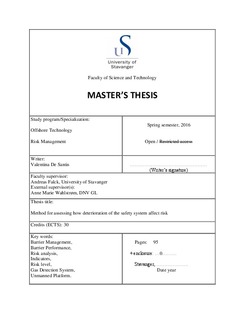| dc.contributor.author | De Santis, Valentina | |
| dc.date.accessioned | 2016-10-03T10:47:27Z | |
| dc.date.available | 2016-10-03T10:47:27Z | |
| dc.date.issued | 2016-06-14 | |
| dc.identifier.uri | http://hdl.handle.net/11250/2412506 | |
| dc.description | Master's thesis in Risk management | nb_NO |
| dc.description.abstract | In the Oil & Gas industry the fundamental element to control major accident hazard is the establishment of an efficient barrier management system. On the NCS the PSA has renewed the strong focus on the barrier and barrier management.
According to the PSA (Petroleum Safety Authority, 2015a) , the industry has to reinforce the link between the risk assessment and the barrier management and special interest should be given on the degradation of the barrier and the system and methodology used to measure it.
The barrier management in operation should be strongly and uniquely linked to the performance requirement, defined in the design phase. As explained in Falck, Flage, and Aven (2015) several methods may be used to identify the performance deviation from the design and operational basis. However, the main challenge is to find models able to reflect the effect of such deviations.
In this thesis work, a new methodology to measure the effect of deterioration of the barrier on risk is proposed. The methodology has been developed for the gas detection system of offshore installations, however it is believed that the methodology could be easily adapted to different barrier system.
The key aspect of the method is the identification of specific indicators; such indicators shall be easily updated by the operators using field data and connected to failure mechanisms of the barrier.
The combination of all indicators is used to build a total score of the barrier that is believed to measure the deviation from the barrier performance requirements; each indicator is combined considering their criticality with respect to the barrier function.
Finally, a relationship between the degradation of the barrier and the risk level is proposed.
The methodology is applied to a case study: an unmanned platform in North Sea. | nb_NO |
| dc.language.iso | eng | nb_NO |
| dc.publisher | University of Stavanger, Norway | nb_NO |
| dc.relation.ispartofseries | Masteroppgave/UIS-TN-IØRP/2016; | |
| dc.rights | Navngivelse 3.0 Norge | * |
| dc.rights | Navngivelse 3.0 Norge | * |
| dc.rights.uri | http://creativecommons.org/licenses/by/3.0/no/ | * |
| dc.subject | offshore teknologi | nb_NO |
| dc.subject | risikostyring | nb_NO |
| dc.subject | risk management | nb_NO |
| dc.subject | barrier management | nb_NO |
| dc.subject | risk analysis | nb_NO |
| dc.subject | barrier performance | nb_NO |
| dc.subject | risikoanalyse | nb_NO |
| dc.title | Method for assessing how deterioration of the safety system affect risk | nb_NO |
| dc.type | Master thesis | nb_NO |
| dc.subject.nsi | VDP::Technology: 500::Marine technology: 580::Offshore technology: 581 | nb_NO |

